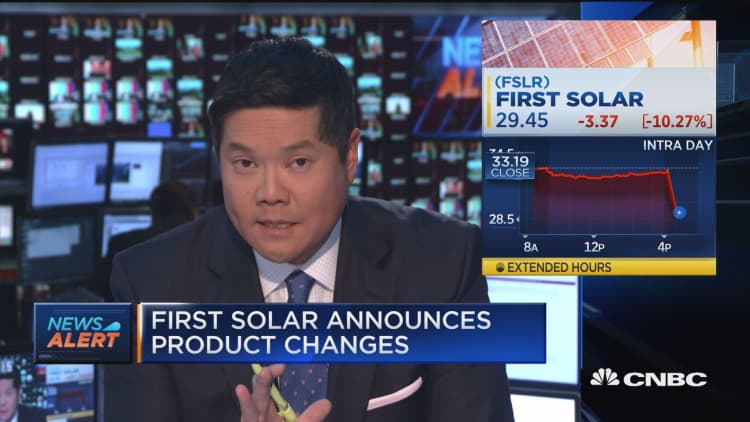Shares of First Solar plunged on Thursday after the company said it would restructure its operations, but some believe the solar panel and systems maker could emerge more fit to fend off low-cost competitors.
First Solar on Wednesday announced it would phase out its current model solar panels, expedite the development of its Series 6 and abandon an intermediate model. Executives said the more efficient Series 6, which will go into production in 2018, would help the company compete in a market that has seen solar panel prices plunge.
The move will also force First Solar to take $500 million to $700 million in impairments and lay off more than a quarter of its workforce. The company also said it now expects to turn in a $2 to $4 per share loss for 2016 and gave disappointing sale guidance for 2017.
First Solar not only designs and manufactures solar panels, but also creates systems to help them run and provides operation and maintenance to power plants.
The company focuses on selling its panels to utility-scale systems rather than to individual homeowners and businesses. Prices for these large photovoltaic systems that came online in 2015 fell 12 percent per watt from the year prior, according to the Department of Energy's Lawrence Berkeley National Laboratory.

Falling prices encourage adoption of solar panels, but they also challenge companies like First Solar to lower costs in order to remain profitable and invest in the future.
Guggenheim Securities estimates the selling prices of the S6 modules will fall about 25 percent from current levels to 33 cents a watt, but the cost of producing them will drop 40 percent to 21 cents a watt.
To be sure, First Solar has operated profitably, unlike many of its competitors, JMP Securities alternative energy analyst Joseph Osha told CNBC. The restructuring is really about regaining its industry leader position by hunkering down for a year and putting a more cost-competitive product on the market.
By bringing the Series 6 to market sooner, First Solar is trying to place itself in a position where it can not only put money in the bank, but reinvest in its business to continue making even more efficient products, Osha explained.
"You can't run your business forever at a level that doesn't allow you to invest in it. That's what the weaker players are trying to do," Osha said. "They're certainly internally hoping that some of this weaker competition just runs out of money."
In a research note, Osha concluded that much will depend on whether Chinese banks and local governments are willing to keep second-tier solar panel manufacturers in business. Low-cost Chinese manufacturers have been instrumental in driving down prices and have faced accusations of dumping subsidized panels into foreign markets.
Consolidation is already well underway in large part because solar panel factories have too much spare capacity, according to the U.S. Energy Information Administration.
Employment in Germany's solar panel manufacturing industry fell from 32,000 to 11,000 between 2008 and 2013. The number of Chinese firms making solar modules and cells meanwhile fell from 300 to fewer than 100, EIA said.
While the industry is consolidating, demand for clean energy is growing. The International Energy Agency forecasts solar's share of global power generation capacity will grow from 4 percent in 2015 to 13 percent in 2040 if planned policies to battle climate change are implemented.
In the United States, the election of Donald Trump has cast uncertainty on government support and subsidies for renewable energy in the near term. The president-elect has vowed to pursue policies aimed at increasing the nation's fossil fuel production.


